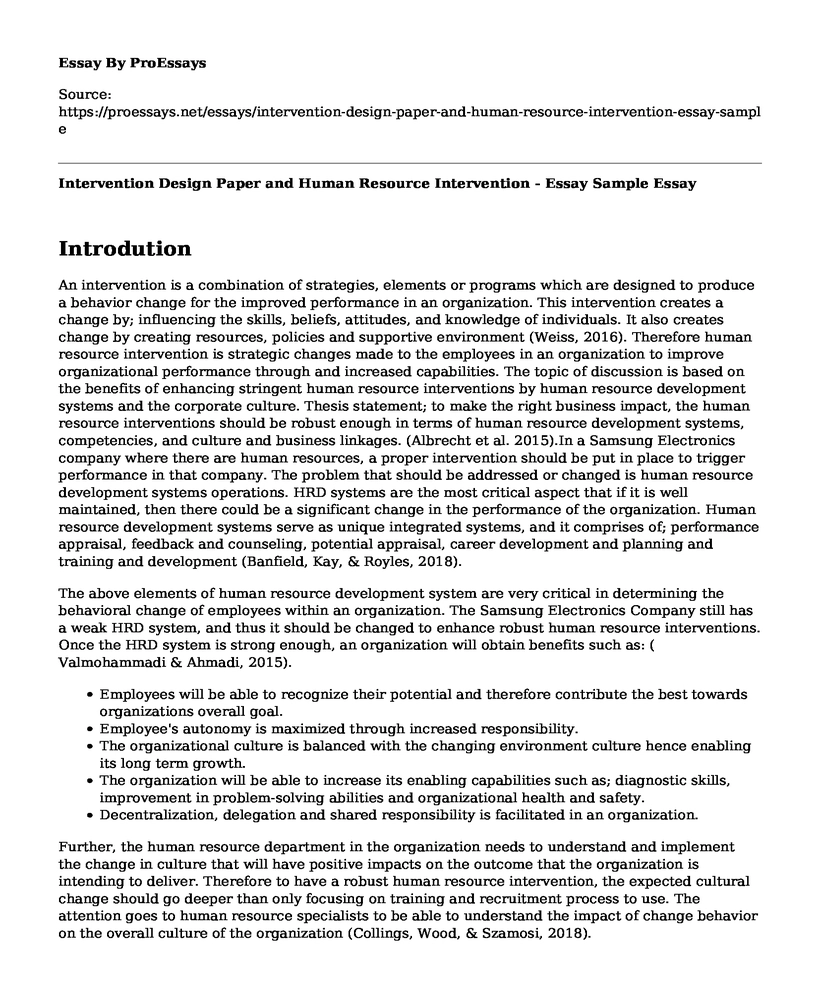Introdution
An intervention is a combination of strategies, elements or programs which are designed to produce a behavior change for the improved performance in an organization. This intervention creates a change by; influencing the skills, beliefs, attitudes, and knowledge of individuals. It also creates change by creating resources, policies and supportive environment (Weiss, 2016). Therefore human resource intervention is strategic changes made to the employees in an organization to improve organizational performance through and increased capabilities. The topic of discussion is based on the benefits of enhancing stringent human resource interventions by human resource development systems and the corporate culture. Thesis statement; to make the right business impact, the human resource interventions should be robust enough in terms of human resource development systems, competencies, and culture and business linkages. (Albrecht et al. 2015).In a Samsung Electronics company where there are human resources, a proper intervention should be put in place to trigger performance in that company. The problem that should be addressed or changed is human resource development systems operations. HRD systems are the most critical aspect that if it is well maintained, then there could be a significant change in the performance of the organization. Human resource development systems serve as unique integrated systems, and it comprises of; performance appraisal, feedback and counseling, potential appraisal, career development and planning and training and development (Banfield, Kay, & Royles, 2018).
The above elements of human resource development system are very critical in determining the behavioral change of employees within an organization. The Samsung Electronics Company still has a weak HRD system, and thus it should be changed to enhance robust human resource interventions. Once the HRD system is strong enough, an organization will obtain benefits such as: ( Valmohammadi & Ahmadi, 2015).
- Employees will be able to recognize their potential and therefore contribute the best towards organizations overall goal.
- Employee's autonomy is maximized through increased responsibility.
- The organizational culture is balanced with the changing environment culture hence enabling its long term growth.
- The organization will be able to increase its enabling capabilities such as; diagnostic skills, improvement in problem-solving abilities and organizational health and safety.
- Decentralization, delegation and shared responsibility is facilitated in an organization.
Further, the human resource department in the organization needs to understand and implement the change in culture that will have positive impacts on the outcome that the organization is intending to deliver. Therefore to have a robust human resource intervention, the expected cultural change should go deeper than only focusing on training and recruitment process to use. The attention goes to human resource specialists to be able to understand the impact of change behavior on the overall culture of the organization (Collings, Wood, & Szamosi, 2018).
Therefore, the complete change in human resource activities will be handled through training which develops the skill but also changes the attitude of workers by involving them in improving the organizational activities and their initiatives. It will encompass timely and value-added management to the organization. The focus of human resource intervention through training is essentially enabling the employees to self-actualize their potentials through the systematic process of developing existing possibilities and creating new ones (Noe, Hollenbeck, Gerhart, & Wright, 2017)
References
Albrecht, S. L., Bakker, A. B., Gruman, J. A., Macey, W. H., & Saks, A. M. (2015). Employee engagement, human resource management practices and competitive advantage: An integrated approach. Journal of Organizational Effectiveness: People and Performance, 2(1), 7-35.
Banfield, P., Kay, R., & Royles, D. (2018). Introduction to human resource management. Oxford University Press.Collings, D. G., Wood, G. T., & Szamosi, L. T. (2018). Human resource management: A critical approach. In Human Resource Management (pp. 1-23). Routledge.
Noe, R. A., Hollenbeck, J. R., Gerhart, B., & Wright, P. M. (2017). Human resource management: Gaining a competitive advantage. New York, NY: McGraw-Hill Education.
Valmohammadi, C., & Ahmadi, M. (2015). The impact of knowledge management practices on organizational performance: A balanced scorecard approach. Journal of Enterprise Information Management, 28(1), 131-159.
Weiss, T. G. (2016). Humanitarian intervention. John Wiley & Sons.
Cite this page
Intervention Design Paper and Human Resource Intervention - Essay Sample . (2022, Dec 11). Retrieved from https://proessays.net/essays/intervention-design-paper-and-human-resource-intervention-essay-sample
If you are the original author of this essay and no longer wish to have it published on the ProEssays website, please click below to request its removal:
- Paper Example on People Management and Leadership
- Organization of Information Security Policies Essay
- Describe a Compensation Strategy for an Organization Paper Example
- Case Study Analysis on Organization Development: North County Legal Services
- Essay Sample on Information Security in Organizations
- The Distinction Between Leadership and Management - Research Paper
- Palm Oil Demand and Supply: Navigating a Complicated Global Supply Chain - Essay Sample







